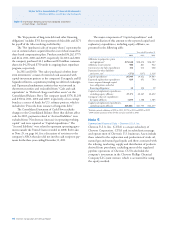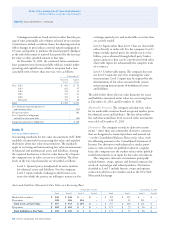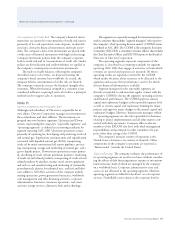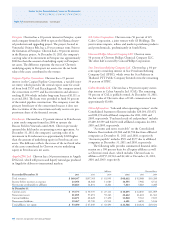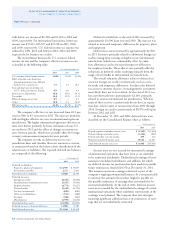Chevron 2011 Annual Report Download - page 44
Download and view the complete annual report
Please find page 44 of the 2011 Chevron annual report below. You can navigate through the pages in the report by either clicking on the pages listed below, or by using the keyword search tool below to find specific information within the annual report.
42 Chevron Corporation 2011 Annual Report
Contingent rentals are based on factors other than the pas-
sage of time, principally sales volumes at leased service stations.
Certain leases include escalation clauses for adjusting rentals to
reect changes in price indices, renewal options ranging up to
25 years, and options to purchase the leased property during or
at the end of the initial or renewal lease period for the fair mar-
ket value or other specied amount at that time.
At December 31, 2011, the estimated future minimum
lease payments (net of noncancelable sublease rentals) under
operating and capital leases, which at inception had a non-
cancelable term of more than one year, were as follows:
At December 31
Operating Capital
Leases Leases
Year: 2012 $ 693 $ 70
2013 632 47
2014 523 32
2015 475 21
2016 393 13
ereafter 793 68
Total $ 3,509 $ 251
Less: Amounts representing interest
and executory costs (55)
Net present values 196
Less: Capital lease obligations
included in short-term debt (68)
Long-term capital lease obligations $ 128
Note 9
Fair Value Measurements
Accounting standards for fair value measurement (ASC 820)
establish a framework for measuring fair value and stipulate
disclosures about fair value measurements. e standards
apply to recurring and nonrecurring fair value measurements
of nancial and nonnancial assets and liabilities. Among
the required disclosures is the fair value hierarchy of inputs
the company uses to value an asset or a liability. e three
levels of the fair value hierarchy are described as follows:
Level 1: Quoted prices (unadjusted) in active markets
for identical assets and liabilities. For the company,
Level 1 inputs include exchange-traded futures con-
tracts for which the parties are willing to transact at the
Notes to the Consolidated Financial Statements
Millions of dollars, except per-share amounts
exchange-quoted price and marketable securities that
are actively traded.
Level 2: Inputs other than Level 1 that are observable,
either directly or indirectly. For the company, Level 2
inputs include quoted prices for similar assets or lia-
bilities, prices obtained through third-party broker
quotes and prices that can be corroborated with other
observable inputs for substantially the complete term
of a contract.
Level 3: Unobservable inputs. e company does not
use Level 3 inputs for any of its recurring fair value
measurements. Level 3 inputs may be required for the
determination of fair value associated with certain
nonrecurring measurements of nonnancial assets
and liabilities.
e table below shows the fair value hierarchy for assets
and liabilities measured at fair value on a recurring basis
at December 31, 2011, and December 31, 2010.
Marketable Securities e company calculates fair value
for its marketable securities based on quoted market prices
for identical assets and liabilities. e fair values reect
the cash that would have been received if the instruments
were sold at December 31, 2011.
Derivatives e company records its derivative instru-
ments – other than any commodity derivative contracts
that are designated as normal purchase and normal sale
– on the Consolidated Balance Sheet at fair value, with
the osetting amount to the Consolidated Statement of
Income. For derivatives with identical or similar provi-
sions as contracts that are publicly traded on a regular
basis, the company uses the market values of the publicly
traded instruments as an input for fair value calculations.
e company’s derivative instruments principally
include futures, swaps, options and forward contracts for
crude oil, natural gas and rened products. Derivatives
classied as Level 1 include futures, swaps and options
contracts traded in active markets such as the New York
Mercantile Exchange.
Assets and Liabilities Measured at Fair Value on a Recurring Basis
At December 31, 2011 At December 31, 2010
Total Level 1 Level 2 Level 3 Total Level 1 Level 2 Level 3
Marketable securities $ 249 $ 249 $ – $ – $ 155 $ 155 $ – $ –
Derivatives 208 104 104 – 122 11 111 –
Total Assets at Fair Value $ 457 $ 353 $ 104 $ – $ 277 $ 166 $ 111 $ –
Derivatives $ 102 $ 101 $ 1 $ – $ 171 $ 75 $ 96 $ –
Total Liabilities at Fair Value $ 102 $ 101 $ 1 $ –
$ 171 $ 75 $ 96 $ –
Note 8 Lease Commitments – Continued










